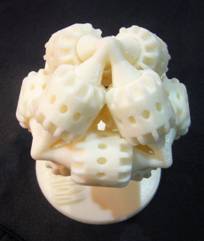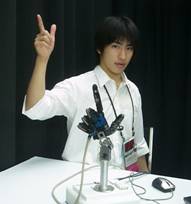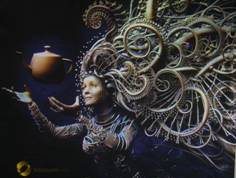SIGGRAPH 2008
By Fred Thorlin
Strong C++ language may be used in these animations.
This cautionary note appeared at the beginning of each sequence of animations shown at the 2008 SIGGRAPH Computer Animation Festival held in Los Angeles’ huge Nokia Theatre. The offerings ranged from selections from commercial releases, such as “Kung Fu Panda”, to the storyless, but technically impressive “Simulating Cloth at the Yarn Level”. An example of the high realism standard appeared in a film called “Stork”. “Our Wonderful Nature” almost rhapsodizes on a beautiful pastoral scene. Almost. Hilarious. I was also impressed by “Box Racer”. The aforementioned three films are available for viewing, some abbreviated, on YouTube.”
Haptics are hot. Haptics is the technology which communicates with the user through the sense of touch. Butterfly Haptics has a very slick device for providing texture feedback as well as real barrier collision response, i.e. you won’t move through their walls. Their all-magnetic system is very smooth to operate. The sensations are accurate across a wide range of surfaces, e.g. sandpaper, ridges, circular grooves. It appears to have a very narrow range of motion, but that was also my first impression when I started using a mouse.
 Stereolithographic, or 3D, printing is making good strides at becoming more accessible. The tools for producing STL files are getting better, e.g. Rhinoceros. The range of print materials and colors is expanding. Shapeways.com has set up a site which will print files sent to them over the Internet. They then offer you a marketplace over which to sell your creation. A nice feature is a viewer allowing rotation of posted objects. They also offer tools to create some, currently two, shapes. The shape called a “Light Poem” is interesting. You enter some text. The text is then rendered in a helix creating a candle holder with your text backlit by the flame. You don’t need to restrict your thinking to static shapes with stereolithography. StrataSys demonstrated a “printed’ machine where a complex set of gears worked together. Stereolithographic, or 3D, printing is making good strides at becoming more accessible. The tools for producing STL files are getting better, e.g. Rhinoceros. The range of print materials and colors is expanding. Shapeways.com has set up a site which will print files sent to them over the Internet. They then offer you a marketplace over which to sell your creation. A nice feature is a viewer allowing rotation of posted objects. They also offer tools to create some, currently two, shapes. The shape called a “Light Poem” is interesting. You enter some text. The text is then rendered in a helix creating a candle holder with your text backlit by the flame. You don’t need to restrict your thinking to static shapes with stereolithography. StrataSys demonstrated a “printed’ machine where a complex set of gears worked together.
Do you want to create a 3D object but you could never get your head around working with four 2D views to create it? Wouldn’t it be reasonable, with existing 3D equipment, to just create the object in space directly with one 3D view? You can by using Leonar3Do, http://www.3dforall.hu/?q=en/node/4. Put on the 3D glasses, whip out the 3D pen and you can start creating in 3D space. After playing with it for a few minutes it did seem workable, except that my shoulder got tired holding the pen up.
 New uses for 3D were demonstrated at several booths. Texas A & M showed one where the structure of the burrow of some leaf-cutting ants was examined by side scanning radar and the resulting structure projected in 3D. A dial allowed you to control the amount of noise in the displayed data. Other projects showcased from academia included: New uses for 3D were demonstrated at several booths. Texas A & M showed one where the structure of the burrow of some leaf-cutting ants was examined by side scanning radar and the resulting structure projected in 3D. A dial allowed you to control the amount of noise in the displayed data. Other projects showcased from academia included:
- A pair of remotely controlled gripping hands controlled by manipulating what felt like a pair of tin cans.
- A hand that mimicked the actions of a human hand monitored by a video camera.
- An anthropomorphic robot that interacted with people nearby.
Most products at the show were in the $1,000++ range. There was a pair of products I found interesting in the under $100 category, both from Smith Micro. Smith is best known for Poser, a popular human modeling toolset costing several hundred dollars. But they also offer Art Rage and Groboto. Art Rage is a texture painting product well suited to working with PhotoShop. In many ways it is similar to Fractal Paint. Tracing, texturing and coloring take it way beyond Paintbrush. Pressure sensitive pens are supported. This is a fun drawing program for under $50. OTOH their Groboto product is... is a… well, it makes pictures too, but of 3-D things; so I guess it is a drawing program, too. That it is a serious art production tool is borne out by the following quote:

“ I was to asked to create the main image for the 2008 Siggraph Animation Festival. I worked with Jill Smolin, the conference entertainment director of the festival this year on both the 3D digital sculpture and a holographic RabbitHoles version for the Nokia Center. Created with Maya 2008 and Groboto. Groboto is an amazing program that I am currently studying. It is created by Braid Art Labs and is worth a look.”-Meats Meier
Textures and images can be imported into Groboto. This enables incorporating photographs into the shapes. The images are generated more than they are painted; think 3-D fractals that live because you can make them move. You can even export them to an OBJ file which permits you to have them printed out as solid objects. It's a fun head trip for under $80. www.groboto.com
The conference did make a swing to the politically correct side this year. Every set of animations began with one entitled “Carbon Footprint” which dwelt on pollution. The organizers went out of their way to note that locals were hired to operate parts of the conference and that badges were to be recycled, not always to good effect.
Recruiting continues to be an increasing part of the SIGGRAPH conference. Over fifty companies, such as UbiSoft and ESPN were looking for 3D artists, designers and game developers in the recruiting area. Others, ranging from LucasFilm to the US Mint, had booths on the main floor. It looks like a booming industry and profession.
PS – For a good time check out eonhuman.ning.com
|

